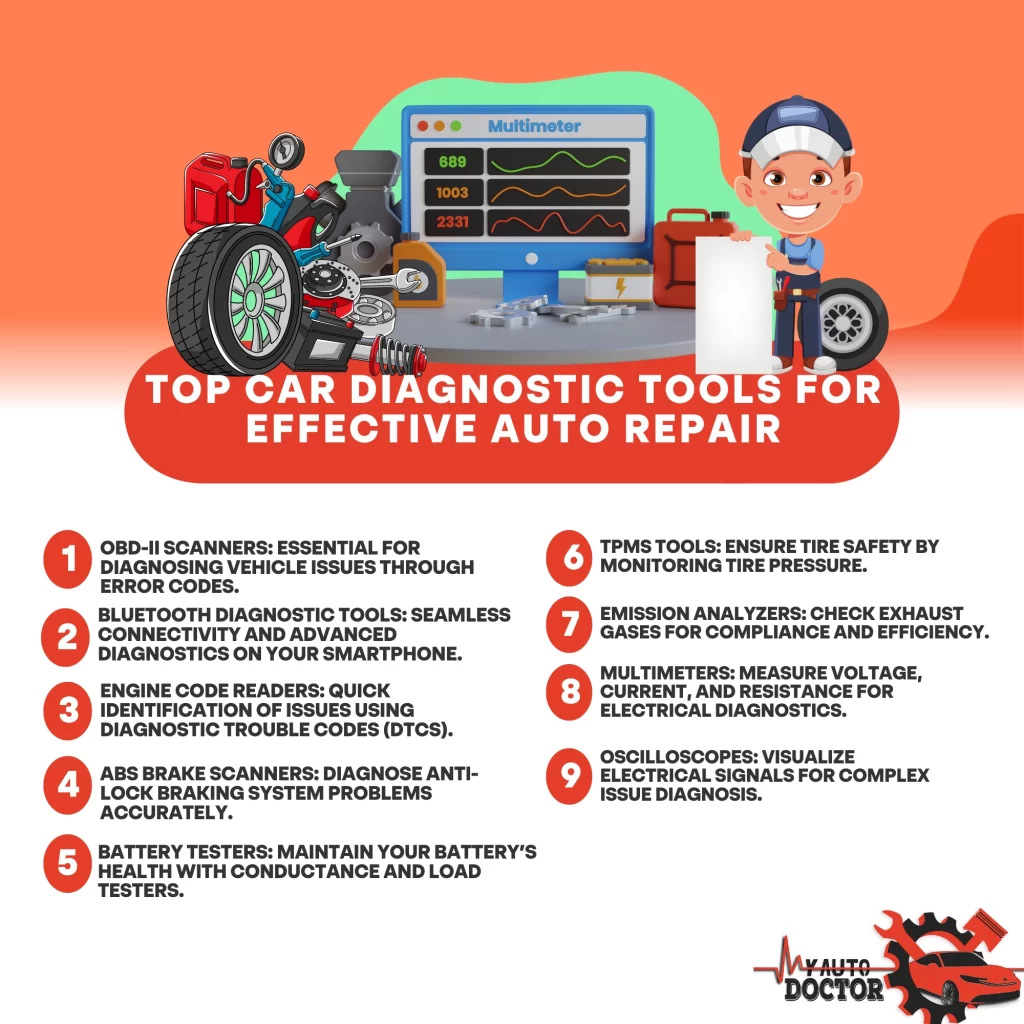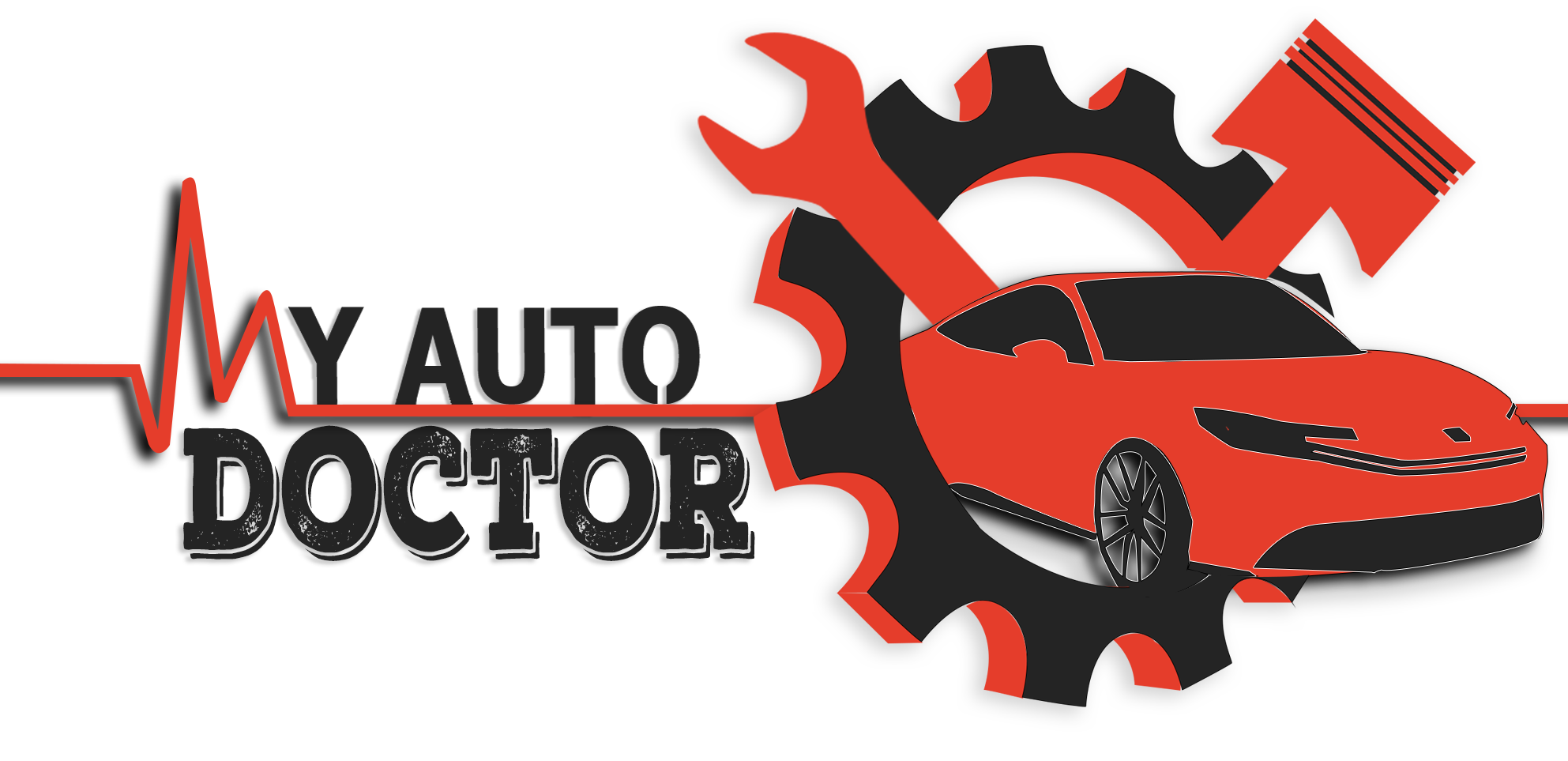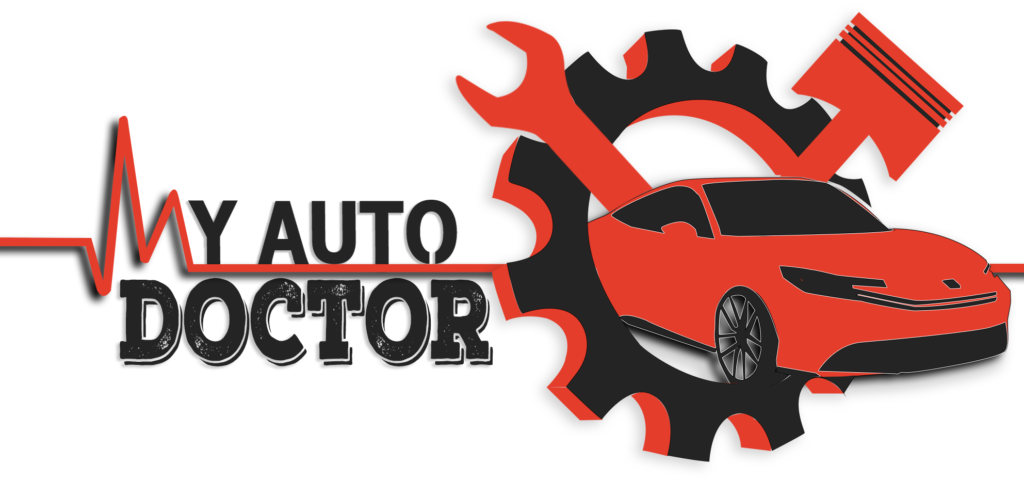Guiding car repairs becomes much simpler when you have the right diagnostic tools at your disposal. Start with OBD-II scanners to interpret error codes and gain insights into your car’s electronic systems. Bluetooth diagnostic tools offer seamless connectivity and advanced diagnostics. Engine code readers help identify issues quickly using Diagnostic Trouble Codes. Use airbag system scanners for accurate SRS assessments, and ABS brake scanners to diagnose anti-lock braking problems. Battery testers maintain your battery’s health, while TPMS tools uphold tire safety. Emission analyzers check exhaust gasses for compliance. For electrical diagnostics, multimeters and oscilloscopes are crucial. Explore further to enrich your auto repair toolkit.

Key Takeaways
- OBD-II scanners diagnose vehicle issues by accessing the onboard diagnostic system and interpreting error codes.
- Bluetooth diagnostic tools offer seamless connectivity and advanced diagnostics with user-friendly interfaces.
- Engine code readers provide real-time data, identifying issues quickly through Diagnostic Trouble Codes (DTCs).
- Battery testers, including conductance and load testers, offer wide voltage compatibility and user-friendly designs.
- Multimeters measure voltage, current, and resistance, aiding in the quick diagnosis of electrical issues.
OBD-II Scanners
An OBD-II scanner is an essential tool for diagnosing and troubleshooting vehicle issues by accessing the car’s onboard diagnostic system. When you’re dealing with car repair and maintenance service, this device can read and interpret error codes generated by your vehicle. It essentially provides a window into the car’s electronic systems, allowing you to identify problems that may not be immediately apparent.
For auto repair shops, having an OBD-II scanner is indispensable. It not only saves time but also guarantees accuracy in diagnosing issues. When a customer brings in their car with a check engine light on, you can quickly connect the scanner to the vehicle’s OBD-II port, usually located under the dashboard. The scanner will then display codes that correspond to specific problems, such as issues with the engine, transmission, or emissions system.
Even if you’re an individual looking to perform some DIY auto repair, investing in an OBD-II scanner can be a game-changer. It gives you the ability to diagnose issues at home, potentially saving you a trip to the auto repair shop. Just make sure to follow the scanner’s instructions and consult your vehicle’s manual for accurate interpretation of the codes.
Bluetooth Diagnostic Tools
When using Bluetooth diagnostic tools, you’ll benefit from their seamless connectivity and broad compatibility with various vehicles. They often feature user-friendly interfaces that make troubleshooting straightforward, even for those with limited technical skills. Additionally, these tools provide excellent cost and value, offering advanced diagnostics without the high price tag of traditional scanners.
Connectivity and Compatibility
Bluetooth diagnostic tools offer unparalleled convenience by allowing you to wirelessly connect your vehicle’s onboard diagnostics system to your smartphone or tablet. This feature is a game-changer for car repair service, enabling you to easily access real-time data without the need for cables or specialized equipment. To make the most of these tools, you need to confirm both connectivity and compatibility with your vehicle.
First, verify that the Bluetooth diagnostic tool supports the specific make and model of your car. Compatibility is vital for accurate readings and effective auto car repair service. Many tools offer broad compatibility, covering a wide range of vehicles, but always double-check the product specifications.
Second, consider the operating system of your smartphone or tablet. Most Bluetooth diagnostic tools are compatible with iOS and Android, but it’s crucial to confirm this before purchase. Incompatible systems can hinder your ability to perform efficient car repair and service.
Lastly, make sure your device has the required Bluetooth version for best performance. Newer tools often require Bluetooth 4.0 or higher for faster data transfer and better stability. By paying attention to these details, you can streamline your car repair and service process, making it more efficient and effective.
User-Friendly Interfaces
After confirming connectivity and compatibility, you’ll find that the user-friendly interfaces of Bluetooth diagnostic tools greatly simplify the car repair process. These tools are designed to make car service repair more accessible, even if you’re not a tech expert. The intuitive interfaces typically feature easy-to-navigate menus and clear visual indicators, which help you quickly identify issues within your vehicle.
Most Bluetooth diagnostic tools connect seamlessly with your smartphone or tablet, offering real-time data and detailed diagnostic reports. You’ll see detailed information such as error codes, sensor readings, and system statuses directly on your device’s screen. Many apps also provide step-by-step guides and possible solutions, which can be invaluable during car service repair tasks.
Additionally, the ability to customize settings and receive updates ensures that your diagnostic tool remains effective and up-to-date. These user-friendly features allow you to focus on addressing the actual problems rather than struggling with complex interfaces. In summary, Bluetooth diagnostic tools bridge the gap between professional-grade equipment and everyday users, making it easier to maintain and repair your vehicle with confidence.
Cost and Value
Evaluating the cost and value of Bluetooth diagnostic tools requires a careful assessment of both the initial investment and long-term benefits. When you’re considering these tools, it’s important to balance upfront costs with the potential savings and advantages they offer over time. Here’s a closer look at what you should consider:
- Initial Investment: Bluetooth diagnostic tools can range from $20 for basic models to over $100 for more advanced versions. It’s vital to make sure that the tool you choose covers the necessary diagnostics for your vehicle make and model.
- Ease of Use and Compatibility: These tools often come with user-friendly apps that can be installed on your smartphone or tablet. Check that the app is compatible with your device and offers extensive features like real-time data monitoring, error code definitions, and maintenance reminders.
- Long-Term Savings: By identifying issues early, you can prevent minor problems from escalating into costly repairs. Regular use of these tools can save you hundreds, if not thousands, in mechanic fees and downtime.
Investing in a Bluetooth diagnostic tool isn’t just about the price you pay upfront; it’s about the ongoing benefits and peace of mind it provides.
Engine Code Readers
When selecting an engine code reader, you’ll want to take into account key features like compatibility, ease of use, and data accuracy. Comparing popular models can help you pinpoint which tools offer the best value and functionality for your needs. Using an engine code reader can save you time and money by quickly diagnosing issues and helping you avoid unnecessary repairs.
Key Features Overview
Engine code readers offer a range of key features that can help you quickly diagnose and troubleshoot issues in your vehicle’s engine system. Understanding these features can make your car maintenance routine more efficient and less stressful.
First, consider the real-time data capability. This feature allows you to view live data from your engine’s sensors, providing immediate insights into the vehicle’s performance. You’ll see parameters like engine RPM, coolant temperature, and fuel system status, which can be vital for pinpointing issues.
Next, multi-code support is important. Modern vehicles generate a variety of diagnostic trouble codes (DTCs) across different systems. A good engine code reader can interpret generic and manufacturer-specific codes, offering you a complete picture of your vehicle’s health.
Lastly, freeze frame data is invaluable. When a malfunction occurs, your engine stores a snapshot of the conditions at that moment. Accessing this data helps you understand the context of the issue and identify the root cause more effectively.
Here’s a quick recap:
- Real-time data: Immediate insights into engine performance.
- Multi-code support: Thorough understanding of different DTCs.
- Freeze frame data: Contextual information for accurate diagnostics.
Investing in a quality engine code reader with these features can transform your auto repair experience.
Popular Models Comparison
Among the most popular engine code readers, you’ll find models like the BlueDriver, Innova 3160g, and the Autel MaxiCOM MK808, each offering unique features designed to address different diagnostic needs. The BlueDriver is a Bluetooth-enabled device that connects to your smartphone. It’s perfect for those who prefer a wireless setup and need extensive data access. It offers live data, freeze frame information, and improved diagnostics for various vehicle systems.
The Innova 3160g stands out with its all-in-one display and user-friendly interface. It can diagnose ABS, SRS, and check engine light issues, making it suitable for DIY enthusiasts who want straightforward functionality. The device also features an on-screen code definition, which helps you understand the problem without needing a separate manual.
On the other hand, the Autel MaxiCOM MK808 is ideal for professional mechanics. It boasts a large touchscreen, advanced coding capabilities, and extensive vehicle coverage. This model supports bi-directional control, allowing you to perform system tests and reset functions, which are essential for in-depth diagnostics.
Usage and Benefits
Utilizing engine code readers can greatly streamline vehicle diagnostics by providing real-time data and pinpointing specific issues efficiently. With these tools, you don’t have to second-guess your car’s problems anymore. By connecting the reader to your vehicle’s OBD-II port, you can quickly access error codes that indicate malfunctioning components. Here’s how to make the most of this technology:
- Identify Issues Quickly: Engine code readers allow you to read and interpret Diagnostic Trouble Codes (DTCs). This can save you countless hours that you’d otherwise spend manually checking various parts.
- Prevent Further Damage: By promptly identifying issues, you can address minor problems before they escalate. This proactive approach can save you from expensive repairs down the line.
- Enhanced DIY Repairs: If you’re a car enthusiast or a DIY mechanic, these tools empower you to handle repairs yourself. You’ll not only save money but also gain a deeper understanding of your vehicle’s health.
You don’t need to be a professional mechanic to use these devices effectively. The straightforward interface and user-friendly design make engine code readers accessible for anyone who wants to maintain their vehicle efficiently.
Airbag System Scanners
Airbag system scanners are crucial diagnostic tools that allow you to identify and troubleshoot issues within your vehicle’s airbag and supplemental restraint systems (SRS). These scanners connect to your car’s onboard diagnostics (OBD-II) port to read and clear fault codes specifically related to the airbag system. When your airbag warning light illuminates, using an airbag system scanner is the first step in pinpointing the problem.
To use an airbag system scanner, plug it into your car’s OBD-II port, usually located under the dashboard. After connecting, the scanner will communicate with the vehicle’s SRS control unit to retrieve error codes. These codes can indicate various issues, such as faulty sensors, wiring problems, or even airbag unit malfunctions.
Once you have the error codes, refer to the scanner’s manual or an online database to understand their meanings. Knowing the specific issue lets you take appropriate action, whether it’s replacing a sensor or fixing a wiring issue. Many advanced scanners also offer live data streaming, allowing you to monitor the SRS system’s real-time performance. This detailed insight ensures that your airbag system remains reliable and functional, enhancing your vehicle’s safety.
ABS Brake Scanners
ABS brake scanners are vital diagnostic tools that help you identify and resolve issues within your vehicle’s anti-lock braking system. These scanners can save you time and money by pinpointing the exact problem, whether it’s a faulty sensor, a malfunctioning ABS module, or issues with the brake lines. To use an ABS brake scanner effectively, you’ll need to connect it to your vehicle’s OBD-II port, usually located under the dashboard.
When choosing an ABS brake scanner, consider the following key features:
- Compatibility: Make sure the scanner is compatible with your specific vehicle make and model. Some scanners are universal, while others are customized to particular manufacturers.
- Real-time Data: Opt for a scanner that provides real-time data and live readings. This feature allows you to observe ABS sensor outputs and other critical metrics as they happen.
- User Interface: A user-friendly interface is vital. Look for scanners with clear displays and easy-to-navigate menus, so you won’t waste time figuring out how to access the information you need.
Using an ABS brake scanner not only helps you diagnose issues accurately but also improves your understanding of your vehicle’s braking system. By addressing ABS problems promptly, you ensure safer driving conditions and extend the lifespan of your braking components.
Battery Testers
When you’re selecting a battery tester, it’s essential to understand the different types available, such as conductance testers and load testers. You should look for key features like accuracy, ease of use, and compatibility with various battery types. These aspects guarantee you get reliable readings and extend your battery’s lifespan.
Types of Battery Testers
Battery testers come in various types, each designed to provide specific information about a vehicle’s battery health and performance. Understanding these different types can help you choose the right tool for your needs.
- Conductance Testers: These are the most common and user-friendly battery testers. They send a small AC signal through the battery to measure its conductance, which correlates with its health. Conductance testers are quick and safe to use, providing immediate results without draining the battery.
- Load Testers: These testers simulate the load a battery would experience during normal operation. By applying a heavy load and measuring the battery’s voltage drop, they can assess the battery’s capacity to hold a charge. Though highly accurate, load testers are bulky and need careful handling to avoid overheating the battery.
- Hydrometers: While a bit old-school, hydrometers are still handy for checking the specific gravity of the electrolyte in each cell of a lead-acid battery. This method provides a detailed insight into the state of charge and health for each cell, making it invaluable for diagnosing individual cell failures.
Choosing the right battery tester can make all the difference in accurately diagnosing and maintaining your vehicle’s battery.
Key Features Explained
Have you ever wondered what key features you should look for when selecting a battery tester to guarantee accurate diagnostics and ease of use? First, consider a tester with a wide voltage range, typically from 6V to 24V. This guarantees compatibility with various battery types, including those in cars, motorcycles, and trucks.
Next, look for a tester with both load testing and conductance testing capabilities. Load testing assesses the battery’s ability to maintain voltage under load conditions, while conductance testing measures its overall health and charge capacity. Combining both provides you with a detailed analysis.
Ease of use is essential. Opt for a tester with a user-friendly interface, preferably one with a backlit LCD screen for easy reading in low-light conditions. Additionally, features like color-coded indicators can help you quickly understand results without needing to interpret complex data.
Portability and durability shouldn’t be overlooked. A compact, lightweight design with a robust casing ensures the tester can withstand tough garage environments. Also, consider units with built-in memory to store multiple test results, allowing you to track battery performance over time.
TPMS Tools
TPMS tools are essential for accurately monitoring and maintaining your vehicle’s tire pressure, guaranteeing safety and peak performance. Without them, you risk driving with under-inflated or over-inflated tires, which can lead to accidents, poor fuel efficiency, and uneven tire wear.
Using a TPMS tool, you can quickly and effectively check your tire pressure and make sure it’s within the manufacturer’s recommended range. Here are three reasons why you need a TPMS tool:
- Safety: Properly inflated tires provide better handling and reduce the risk of blowouts. This is especially critical during high-speed driving or in adverse weather conditions.
- Efficiency: Maintaining the correct tire pressure improves fuel efficiency. Under-inflated tires can increase rolling resistance, causing your vehicle to consume more fuel.
- Longevity: Correct tire pressure extends the lifespan of your tires by preventing uneven wear. This saves you money in the long run on tire replacements.
When selecting a TPMS tool, look for features like real-time pressure readings, compatibility with different vehicle models, and ease of use. Some advanced models even offer wireless connectivity, allowing you to monitor tire pressure from your smartphone. By investing in a quality TPMS tool, you’re taking an important step in proactive vehicle maintenance.
Emission Analyzers
In today’s strict regulatory environment, emission analyzers are essential tools for guaranteeing your vehicle complies with environmental standards. These devices measure the levels of various gases like carbon monoxide (CO), hydrocarbons (HC), carbon dioxide (CO2), and nitrogen oxides (NOx) in your vehicle’s exhaust. By analyzing these emissions, you can pinpoint inefficiencies in the combustion process and identify malfunctioning components such as oxygen sensors, catalytic converters, and fuel injectors.
To use an emission analyzer effectively, first make sure your vehicle is at operating temperature. Connect the analyzer’s probe to the exhaust tailpipe, ensuring a snug fit to avoid air leaks. Follow the device’s prompts to initiate the test. The analyzer will then display the concentration of each gas, typically in parts per million (ppm) or percentages.
Understanding the readings is essential. High CO levels indicate incomplete combustion, often due to a rich fuel mixture. Elevated HC levels suggest unburnt fuel, indicating potential ignition issues. High NOx levels can result from excessive combustion temperatures, often tied to EGR system failures. Regularly using an emission analyzer not only helps you stay compliant with regulations but also ensures your vehicle runs efficiently, reducing long-term maintenance costs.
Multimeters
While emission analyzers help you monitor your vehicle’s exhaust gases, multimeters are essential for diagnosing electrical issues in your car. With a multimeter, you can measure voltage, current, and resistance, which are vital for troubleshooting problems like a dead battery, faulty wiring, or malfunctioning sensors.
First, make sure your multimeter is set to the correct measurement type—voltage (V), current (A), or resistance (Ω). This fundamental step prevents incorrect readings and potential damage to the device. When measuring voltage, always connect the multimeter probes in parallel with the circuit under test.
Here are three reasons why you need a multimeter in your toolkit:
- Quick Diagnostics: Instantly check battery voltage to determine if it needs replacing.
- Accurate Measurements: Precisely measure resistance in circuits to identify faulty components.
- Preventative Maintenance: Regularly test your vehicle’s electrical system to catch issues before they escalate.
When testing current, place the probes in series with the circuit. Always start with the highest current setting to avoid overloading the multimeter. Remember, consistency in your diagnostic approach will lead to more accurate troubleshooting and quicker repairs. So, get comfortable with your multimeter—you’ll wonder how you ever managed without it.
Oscilloscopes
Harnessing the power of oscilloscopes, you can visualize electrical signals in your vehicle’s circuits, making it easier to diagnose complex issues that multimeters can’t detect. Unlike multimeters, which only measure voltage and resistance, oscilloscopes provide a dynamic view of the waveform of electrical signals. This helps you identify irregularities like voltage spikes, drops, or noise that could point to failing components.
First, connect the oscilloscope probes to the circuit you want to test. You’ll see real-time waveforms on the screen. Pay attention to the amplitude, frequency, and shape of the waveforms. Any deviations from the expected patterns can reveal issues like faulty sensors, poor ground connections, or degraded wiring.
Make sure to adjust the time base and voltage settings on your oscilloscope to match the characteristics of the signal you’re measuring. For instance, slow signals require a longer time base, while high-frequency signals need a shorter one.
Using an oscilloscope effectively requires practice. Start with known good circuits to understand what normal waveforms look like. As you gain experience, you’ll be able to quickly spot anomalies, making your diagnostics more accurate and efficient.
Frequently Asked Questions
How Often Should I Perform a Full Diagnostic Check on My Car?
You should perform a full diagnostic check on your car at least once a year. Regular checks help catch issues early, guaranteeing your car runs smoothly and prevents costly repairs. Always follow your car manufacturer’s maintenance schedule.
What Are the Benefits of Using Professional Diagnostic Tools Over Consumer-Grade Ones?
Think of professional tools like Sherlock Holmes’ magnifying glass. They provide more accurate diagnostics, extensive data, and advanced features. You’ll catch issues early, save on repairs, and maintain your car’s health better than consumer-grade tools can.
Can Diagnostic Tools Detect Issues With Hybrid or Electric Vehicles?
Yes, diagnostic tools can detect issues with hybrid or electric vehicles. You’ll need advanced tools designed specifically for these vehicles to diagnose battery health, motor functionality, and other electronic components accurately. Invest in specialized equipment.
Do I Need Any Special Training to Use Advanced Car Diagnostic Tools?
You don’t need formal training to use advanced car diagnostic tools, but it helps. Familiarize yourself with the tool’s manual and online tutorials. Practical knowledge of vehicle systems boosts your effectiveness and accuracy in diagnosing issues.
Are There Specific Tools Recommended for European or Asian Car Models?
Yes, you’ll need specific tools for European or Asian car models. For European cars, consider Autel MaxiCOM or Launch X431. For Asian vehicles, tools like the Foxwell NT530 or BlueDriver OBD2 are recommended.
Conclusion
ready to turn you into a car whisperer. Don’t forget those ABS brake scanners and TPMS tools—because who doesn’t love a good airbag check? Emission analyzers will keep you green, while multimeters and oscilloscopes add the final dash of nerdy flair. With these tools, you’ll not only fix your car but probably outwit it. Happy diagnosing!








